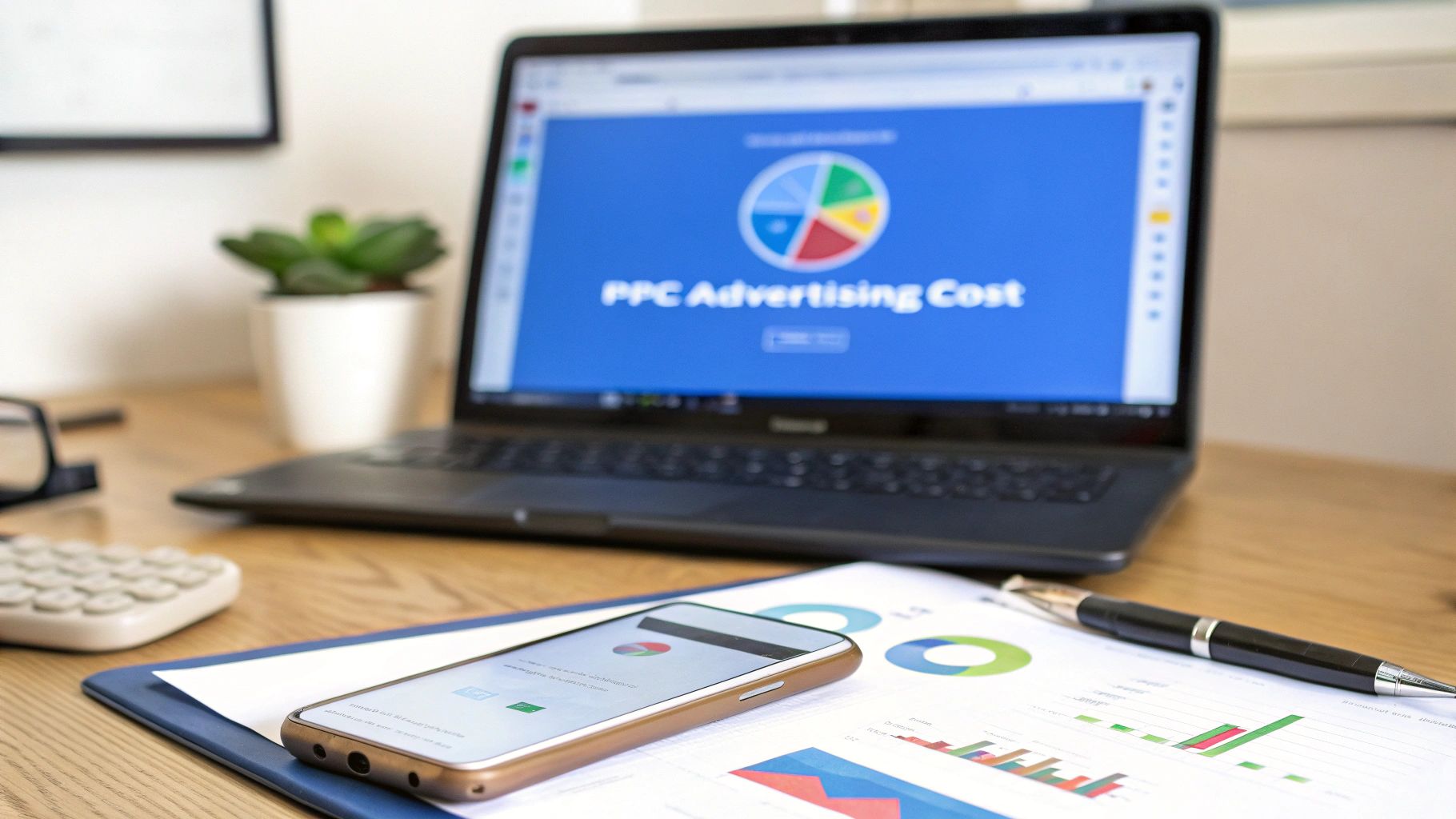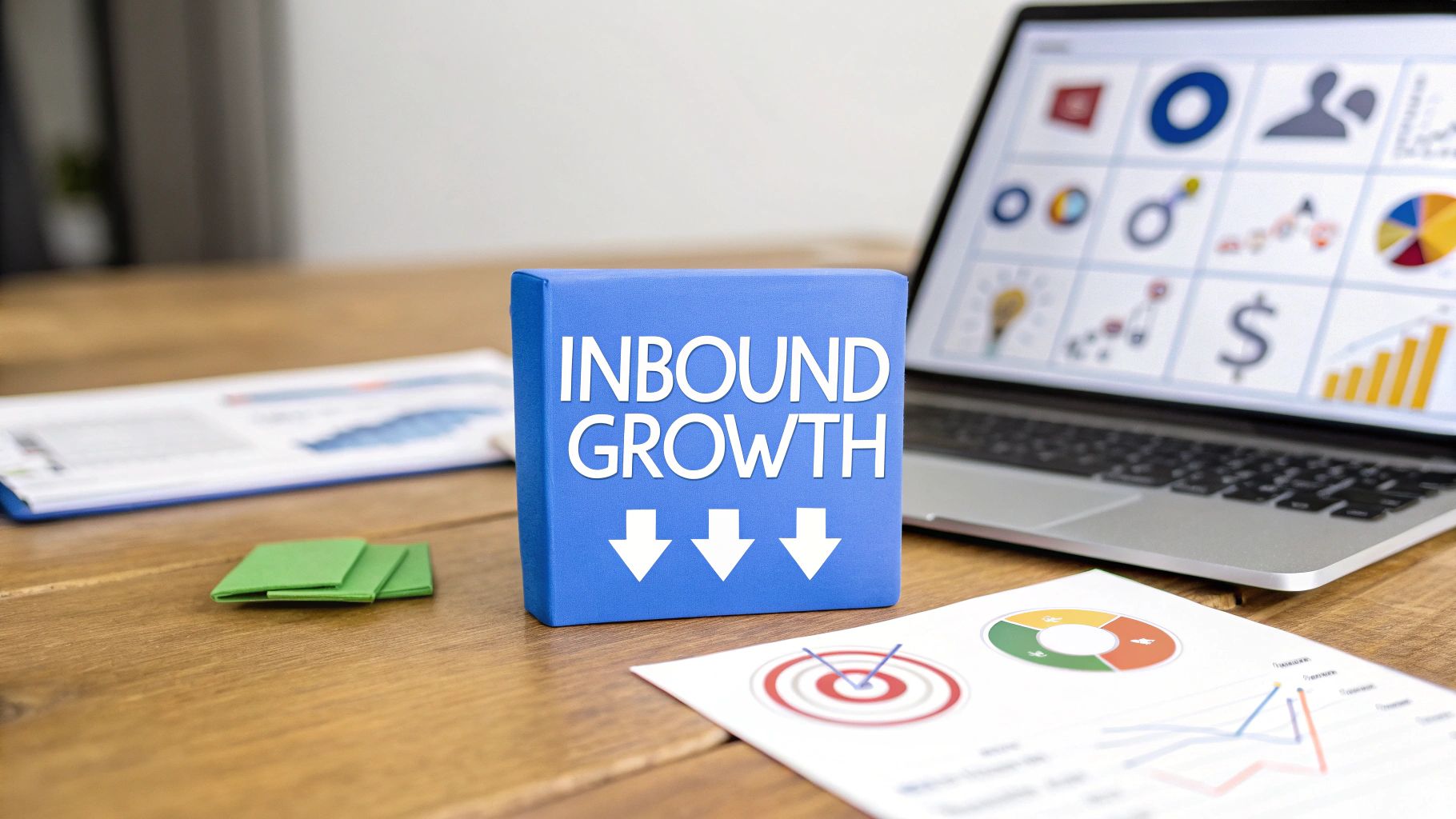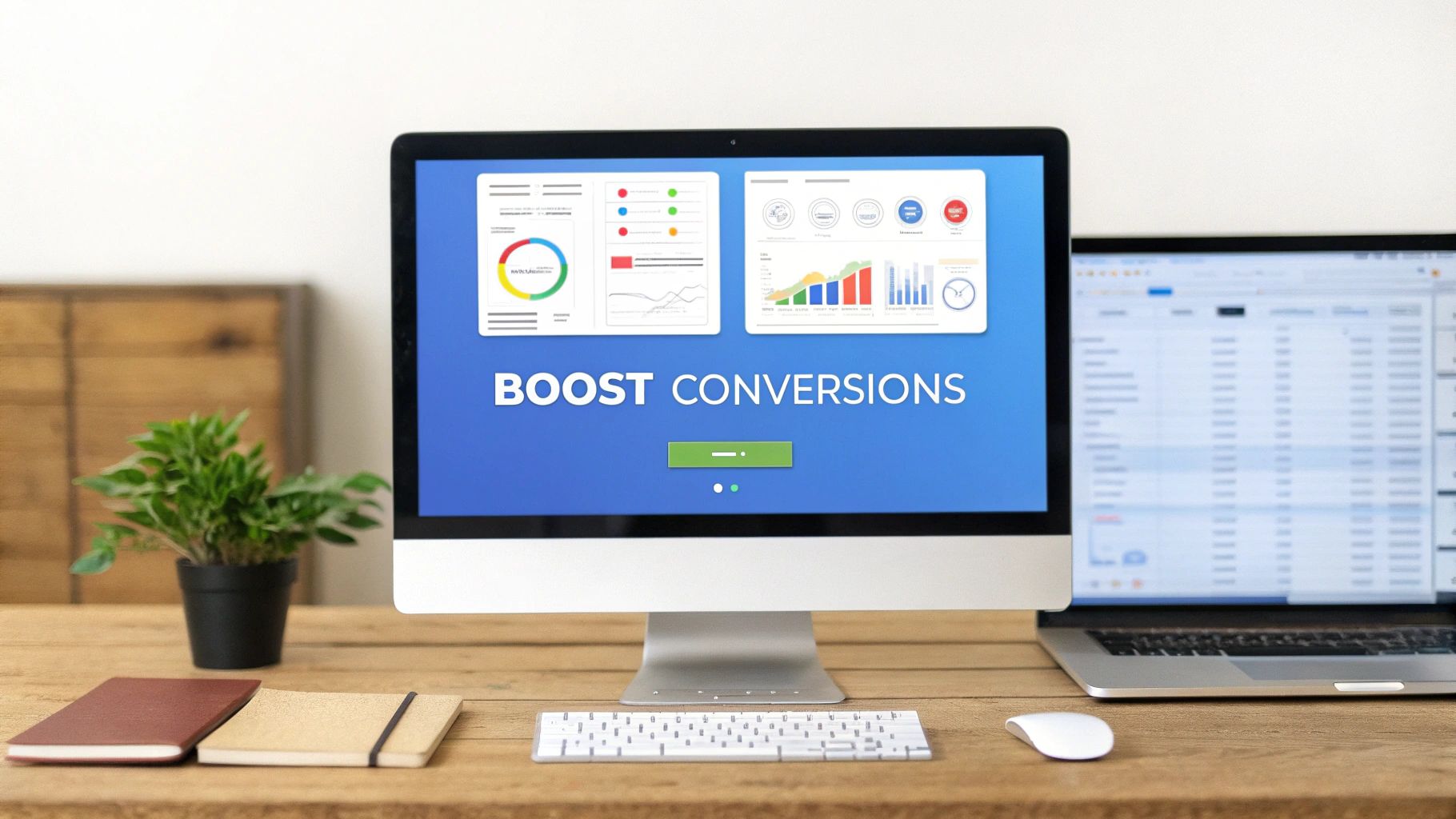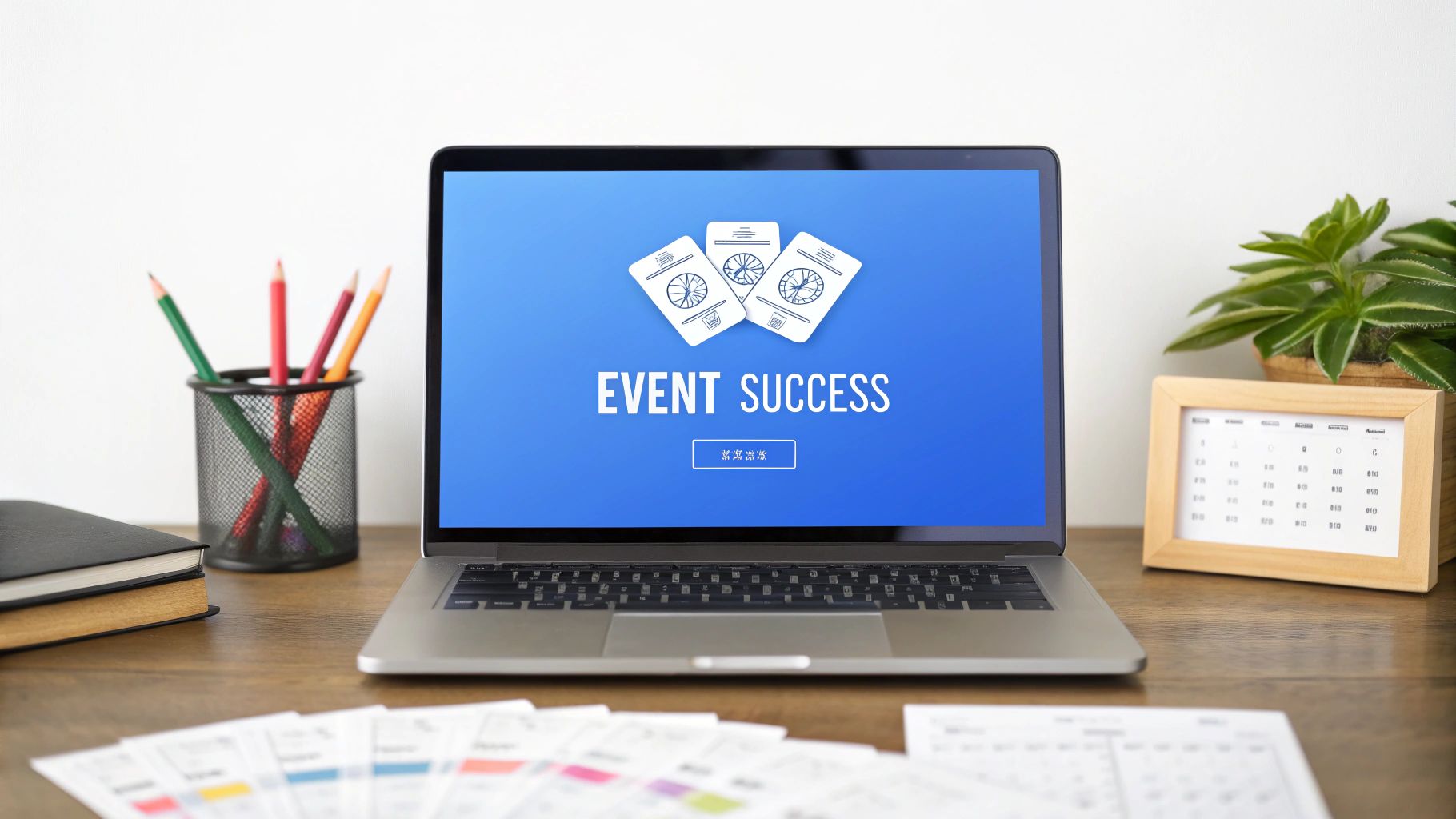Summary
Meta Description: How much does PPC advertising cost? Our guide breaks down the factors that influence your ad spend, from CPC and Quality Score to industry benchmarks.
"How much does PPC advertising cost?" It's the question every marketer asks. While the average business might spend anywhere from $1,000 to $10,000 a month on Google Ads, that figure is just a starting point. The real answer? It depends entirely on your industry, goals, and campaign strategy.
Ready to understand what really drives that number?
Deconstructing Your PPC Advertising Investment
Thinking about pay-per-click (PPC) costs can feel intimidating. Are you signing up for a fixed monthly bill? Is it a subscription? Not at all. It’s much more like an electricity bill—you only pay for what you use, and you have a surprising amount of control over the final cost.
The key is to shift your mindset from "buying ads" to bidding for a potential customer's attention in a live, competitive marketplace.
To truly grasp PPC costs, it helps to see where it fits within the broader picture of Search Engine Marketing (SEM). While SEM is the entire toolkit, PPC is the most direct, results-driven tool you have. Your budget isn't a sunk cost; it's a dynamic investment designed to drive targeted traffic and leads right now.
Key Budgeting Considerations
Before launching any campaign, you need to know what factors will shape your spending. A few core elements always determine your final bill. Do any of these sound familiar?
- Your Industry: A single click for a "personal injury lawyer" could cost over $50. In contrast, a click for "handmade coffee mugs" might be less than a dollar. The potential value of a customer directly drives the price.
- Keyword Competitiveness: It's pure supply and demand. High-demand keywords with clear purchase intent cost more because everyone wants a piece of that action.
- Ad Quality: Here’s a little-known secret: platforms like Google actually reward you for good ads. A more relevant, higher-quality ad can earn you a discount on your clicks, saving you money.
- Targeting Precision: How you dial in your location, time of day, and device targeting has a massive impact on how efficiently you spend every dollar.
Understanding Market Fluctuations in Ad Spend
The digital ad market is always moving. For instance, the average global cost-per-click (CPC) for search ads hovered around $0.62 in early 2024, a slight increase from previous quarters.
This shows how competition and evolving platform algorithms create a pricing environment that’s anything but static. Platforms like Google Ads, which dominate the market, naturally have higher CPCs because the competition is fierce. Keeping an eye on these trends is crucial for managing your budget effectively. To dive deeper into what drives these costs, check out this in-depth CPC analysis.
Decoding Your PPC Bill: How the Ad Auction Works
To get a handle on your PPC costs, you must understand where the money goes. It’s not as simple as paying a flat rate. Every time someone searches for your keywords, a lightning-fast auction happens behind the scenes to decide which ads appear and in what order.
Think of Cost-Per-Click (CPC) as paying a small fee each time an interested customer walks through your digital door. You aren’t paying for window shoppers; you're paying specifically for the action of someone engaging with your ad. This model ensures your budget is spent attracting active interest.
But who wins the auction? It's a common myth that the advertiser with the deepest pockets always wins. While your bid is important, it's only one piece of the puzzle.
More Than Just a Bidding War
Google’s ad auction rewards advertisers who provide a great user experience. It’s less like a traditional auction and more like a talent show where both skill and investment matter. This is where a crucial metric called Quality Score comes into play.
Quality Score is Google's rating of your campaign's quality and relevance, covering your ads, keywords, and landing pages. It’s a simple score from 1 to 10, and a higher score can lead to lower prices and better ad positions. In short, Google gives you a discount for being helpful.
This concept map breaks down the core elements that feed into your final PPC cost, showing how your industry, keyword choices, and ad quality are all connected.
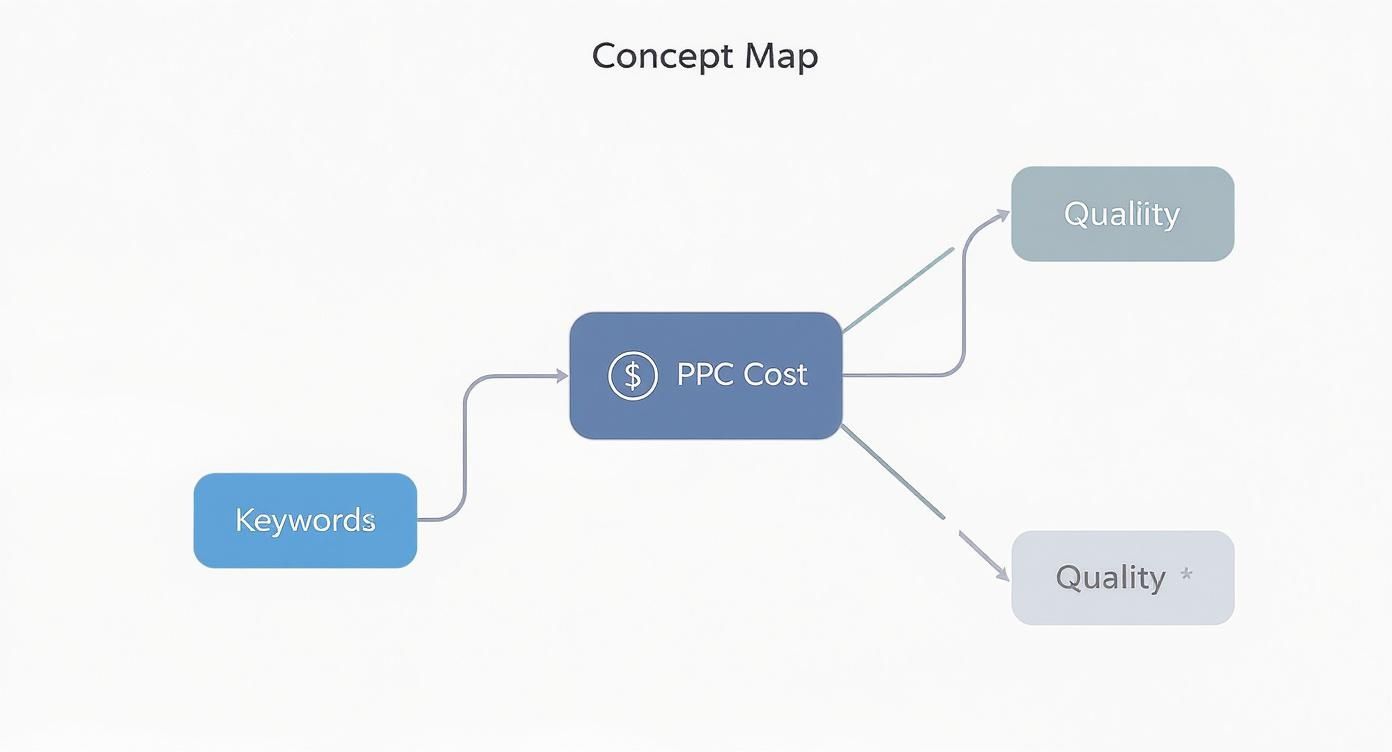
As the graphic shows, while external factors like your industry set a cost baseline, your ad quality is a powerful lever you can pull to directly lower your spend.
How Ad Rank Determines Your Actual Cost-Per-Click
To determine the auction winner, Google calculates a value called Ad Rank for every advertiser. The formula is simple but powerful:
Ad Rank = Your Maximum CPC Bid x Your Quality Score
Advertisers with the highest Ad Rank scores win the top ad spots. This system allows a small business with a high Quality Score to outrank a massive competitor with a huge budget but less relevant ads. You don't have to outspend your competition; you just have to outsmart them.
So, how does this affect what you actually pay? The formula for your actual cost-per-click is even more interesting:
- Your Actual CPC = (Ad Rank of the advertiser below you / Your Quality Score) + $0.01
This means you only pay the minimum needed to hold your position over the advertiser ranked just below you. A higher Quality Score directly shrinks this amount, making it the most effective tool for cost control. Understanding and optimizing this score is everything, and a detailed pay-per-click report can show you where to focus your efforts.
The Three Pillars of a High Quality Score
Improving your Quality Score isn't a secret art. It all boils down to focusing on three main components Google uses to evaluate your ads. Master these, and you can systematically bring your costs down.
- Expected Click-Through Rate (CTR): This is Google's prediction of how likely people are to click your ad. It's heavily influenced by your past ad performance and how compelling your ad copy is.
- Ad Relevance: This measures how closely your keyword relates to your ad. If someone searches for "men's running shoes," your ad needs to talk about men's running shoes, not just "footwear." It’s that simple.
- Landing Page Experience: When someone clicks your ad, does the landing page deliver on the promise? A great landing page is relevant, easy to navigate, and has a clear next step for the user.
By continuously improving these three areas, you send a clear signal to Google that you're a high-quality advertiser. In return, the platform rewards you with a better Ad Rank and a lower cost for each click.
Why PPC Click Costs Vary So Widely
Ever wonder why bidding on "personal injury lawyer" costs a fortune, while "handmade coffee mugs" is pocket change? The cost of a PPC click directly reflects a keyword's potential value, driven by powerful market forces.
Two massive factors are at play: commercial intent and customer lifetime value (CLV). Someone searching for a lawyer has an urgent, high-value problem. Businesses know a single client from that click could be worth thousands, so they bid aggressively. In contrast, a coffee mug is a small purchase, meaning advertisers can only afford to spend a few dimes to get that click.
This dynamic creates a huge range of costs across different industries. What you sell has a direct—and massive—impact on what you'll pay.
How Your Industry Shapes Your Ad Spend
Let's be blunt: some industries are just more expensive to advertise in. If a single lead is worth a lot of money, the competition will be fierce, and the cost of admission goes way up. It’s the fundamental rule of PPC.
Sectors like legal services, finance, and home repair are notoriously pricey. A new client can bring in thousands of dollars, leading to intense bidding wars. In contrast, industries like retail or hobbies usually have lower CPCs because the profit on each sale is smaller, keeping bids grounded.
To give you a clearer picture, here’s a look at how average CPCs stack up across different sectors on the Google Ads Search Network.
Average Cost-Per-Click by Industry
This table offers a snapshot of the cost differences you can expect, showing how high-cost, mid-cost, and low-cost industries compare.
As you can see, your business type is one of the biggest factors determining your ad spend. Knowing where you land on this spectrum is the first step toward building a realistic budget.
What Other Factors Make PPC Costs Fluctuate?
Your industry sets the baseline, but other factors can make your PPC costs swing, sometimes dramatically. Getting ahead of these shifts is crucial for managing your budget.
Here are a few of the biggest movers:
- Seasonality: Costs almost always spike during peak seasons. A tax accountant's CPC will soar in March and April, just like a retailer's will during Black Friday. Plan for these surges.
- Geographic Targeting: Bidding on keywords in a major hub like New York City will always cost more than in a small rural town. More people mean more competition.
- Device Type: Mobile clicks can sometimes be cheaper, but not always. A search for an "emergency plumber near me" from a phone is a high-intent, high-value lead, and mobile bids will reflect that.
Global economic trends and local market competition also play a huge part. For example, data from May 2023 showed the average CPC for search ads in the UK was $1.22. But in Brazil's marketing sector? It was a whopping $4.22. This is why a one-size-fits-all budget just doesn't work. Digging into regional and industry CPC statistics can give you a smarter way to shape your strategy.
How to Lower Your Ad Spend with Quality Score

If you're looking for the most powerful way to control your PPC costs, look no further. Quality Score isn't just another vanity metric; it's the engine driving Google's ad auction and your best friend for getting more for your money.
Think of it as your reputation with Google. It’s a score from 1 to 10 that signals how relevant and useful your ads, keywords, and landing pages are.
A high score is a stamp of approval. Google sees you’re giving users a great experience and rewards you with better ad positions and a discount on your cost-per-click (CPC). It’s entirely possible for a competitor to bid more than you and still rank lower simply because your Quality Score is higher.
The Three Pillars of Quality Score
Improving your score isn't a mystery. It all comes down to three core components that Google constantly evaluates. Nail these, and you'll watch your ad costs drop.
- Expected Click-Through Rate (CTR): This is Google’s prediction of how likely people are to click your ad when it shows up, based heavily on past performance.
- Ad Relevance: How well does your ad copy match what the user searched for?
- Landing Page Experience: Once someone clicks, does the page they land on deliver on the ad's promise? Is it relevant, trustworthy, and easy to navigate?
Mastering these areas gives you direct control over how much you pay for every click.
Actionable Ways to Improve Expected CTR
Your expected CTR measures how enticing your ad is. A high CTR tells Google your ad is a perfect match for what people are looking for. How can you boost it?
Write ad copy people can't help but click. Use strong, action-oriented verbs, highlight unique selling points (like "Free Shipping" or "24/7 Support"), and create a sense of urgency.
For example, a generic headline like "Plumbing Services" is forgettable. But "Emergency Plumber On Call Now" speaks directly to an urgent need, making it far more likely to get the click.
Ad extensions are another easy win. Sitelinks, callouts, and structured snippets give you more screen real estate, making your ad bigger, more informative, and harder to ignore.
Nailing Ad Relevance with Smart Structure
Ad relevance is all about alignment. If someone searches for "women's hiking boots," your ad needs to talk about women's hiking boots—not just "outdoor footwear." The secret to this is creating tightly themed ad groups.
Don't dump hundreds of keywords into one massive ad group. Instead, break them down into small, hyper-specific groups.
- Broad Ad Group (Bad): Keywords like "shoes," "boots," "running shoes," "hiking boots."
- Themed Ad Group (Good): Keywords like "women's waterproof hiking boots," "hiking boots for women," "best women's hiking boots."
This simple restructuring lets you write incredibly relevant ad copy that mirrors the exact words your customers use. This is a foundational step when you learn how to improve Quality Score and gain an edge on the competition.
Optimizing Your Landing Page Experience
Getting the click is only half the battle. Google follows the user to your landing page to ensure the experience is seamless and valuable. A clunky landing page can kill your Quality Score, even with a perfect ad.
Start with the basics: your page must load fast. We're talking lightning-fast. Nearly 53% of mobile users will leave if a page takes more than three seconds to load.
Beyond speed, the message on your landing page must match the promise in your ad. The headline, content, and call-to-action should all feel like a natural continuation of the user's journey. Finally, make your page easy to navigate and be transparent about your business—it builds trust with both visitors and Google.
How to Forecast a Realistic PPC Budget
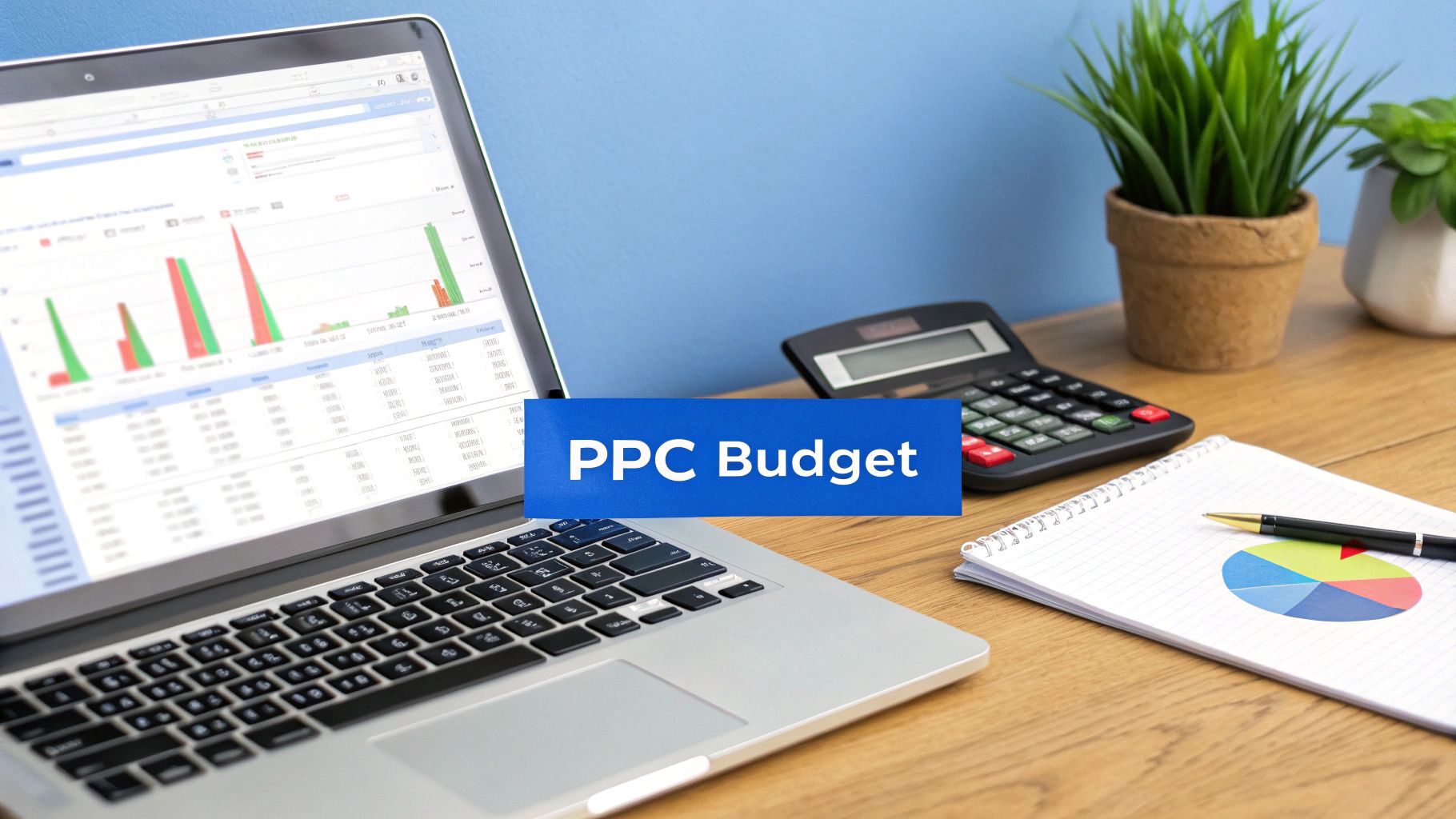
Let's move from theory to action. It's time to build a PPC budget that aligns with your business goals. A solid forecast prevents you from spending too little to make an impact or overspending without seeing a clear return.
The process is more straightforward than you might think, and it all starts with research.
Your first stop should be a free tool like the Google Keyword Planner. This gives you a sneak peek at invaluable data for the keywords you want to target.
You can uncover two critical pieces of information:
- Average Monthly Searches: This tells you the potential audience size for each keyword.
- Bid Range Estimates: This shows what other advertisers are typically paying per click for those keywords.
This initial research provides a data-backed foundation, turning guesswork into a concrete plan.
Start with a Keyword-Driven Forecast
Once you have your keyword data, you can build a basic monthly forecast. This bottom-up approach estimates traffic and costs based on your target keywords.
Here’s a simple formula to get you started:
Estimated Clicks x Average Cost-Per-Click = Estimated Monthly Spend
Let’s say you’re targeting keywords with an average CPC of $2.50 and you want to drive 400 clicks a month. Your starting budget forecast would be $1,000 ($2.50 x 400). This quick calculation provides a clear baseline for what it might cost to hit your initial traffic goals.
This method is an excellent way to ground your budget in reality and understand the direct link between your keyword choices and your overall PPC advertising cost.
Work Backward from Your Business Goals
An even more powerful approach is to work backward from what you actually want to achieve. Instead of asking, "How much traffic can I get?" you ask, "What do I need to spend to hit my lead or sales targets?" This directly ties your ad spend to revenue.
To do this, you need your target Cost Per Acquisition (CPA)—the maximum amount you’re willing to spend to land one new customer while still turning a profit.
Once you know your target CPA and your website's average conversion rate, the formula is simple:
- Determine Your Target Leads: How many new leads or sales are you aiming for this month? Let's say 20.
- Estimate Clicks Needed: If your landing page converts at 2%, you'll need 1,000 clicks to get 20 leads (20 leads / 0.02 conversion rate).
- Calculate Your Budget: If your average CPC is $3.00, your projected monthly budget is $3,000 (1,000 clicks x $3.00 CPC).
This goal-oriented approach transforms your PPC budget from an expense into a strategic investment tied directly to growth. To ensure that investment pays off, you’ll want to follow some proven strategies. These 10 Google Ads best practices to maximize ROI are a great place to start.
Common Questions About PPC Advertising Costs
Diving into pay-per-click advertising can feel like trying to hit a moving target, especially with your budget. Let’s clear the air and tackle some of the most common questions advertisers have. My goal is to give you clear, practical answers so you can manage your ad spend with confidence.
How Much Should a Small Business Budget for PPC?
This is the big question, isn't it? A widely accepted starting point for small businesses is somewhere between $500 and $2,500 a month.
But here’s the most important rule: start with an amount you are genuinely comfortable testing.
Think of your initial budget as an investment in data, not just clicks. This mindset lets you gather crucial performance insights without financial risk. To make that test budget count, stay focused. Don't target dozens of keywords at once. Instead, pick a small, highly-focused set of keywords that signal clear buying intent.
As data rolls in, you’ll see which ads and keywords are making the phone ring. From there, you can optimize your campaigns, improve your Quality Score, and confidently scale your budget based on your return on ad spend (ROAS). It's not about spending more; it’s about spending smarter.
What Is Considered a Good Cost-Per-Click?
Let's bust a myth: a universal "good" CPC does not exist. A good cost-per-click is entirely relative to your business model, profit margins, and what a customer is actually worth to you.
For instance, a law firm might be thrilled to pay a $50 CPC. Why? Because a single new client could mean $10,000 or more in revenue. That click cost is a drop in the bucket. In contrast, an e-commerce store with a $10 profit margin would go out of business paying a $5 CPC.
Instead of obsessing over CPC, focus on your Cost Per Acquisition (CPA). Your CPA tells you exactly what it costs to get one new paying customer.
If you know you can profitably spend up to $40 to land a new customer, then any CPC that keeps your CPA below that $40 threshold is a "good" CPC for your business. This shifts your focus from the cost of a single click to the overall profitability of your campaign—and that’s what really drives growth.
Are Google Ads More Expensive Than Facebook Ads?
Generally, Google Ads has a higher average cost-per-click than Facebook Ads. This isn't random; it comes down to the fundamental difference in user intent on each platform.
Google Ads is all about active search intent. Someone typing into Google is actively looking for a solution right now. Their clicks are more valuable because they're already partway through the buying journey.
Facebook Ads, on the other hand, is built on passive discovery. You show ads to people based on their interests and online behavior, interrupting their scrolling to show them something you think they'll like.
Here’s how the trade-offs shake out:
Google Ads:
- Higher CPC: You pay a premium for high-intent traffic.
- Higher Conversion Rates: These users are actively looking for what you sell.
- Best for: Capturing immediate demand for specific products or services.
Facebook Ads:
- Lower CPC: Clicks are usually cheaper because user intent is lower.
- Lower Conversion Rates: Your job is to create demand from scratch.
- Best for: Building brand awareness and reaching new audiences.
So, which is "better"? It depends on your goals. Need to drive sales for a defined service today? Google Ads is likely your best bet. Trying to introduce a new product to a specific demographic? Facebook’s lower costs might be the smarter play.
Why Are My PPC Costs Increasing?
It’s a frustrating feeling to watch your PPC costs climb, but it’s rarely a mystery. If you're seeing your ad spend rise, it's almost always due to one of a few predictable factors. Figuring out the "why" is the first step to getting things back on track.
The most common culprit is increased competition. PPC is an auction. As more businesses enter your market and bid on the same keywords, the price for a top spot naturally goes up.
Another huge factor could be a declining Quality Score. If your ad copy is stale, your landing page is clunky, or your click-through rates are dropping, Google will start charging you more per click. A low Quality Score is like a tax for a poor user experience.
Finally, never underestimate seasonality. Costs in many industries spike during peak times. For retailers, that's Q4. For a tax service, costs will soar in the months leading up to April.
To fight rising costs, be proactive. Constantly audit your campaigns to cut what isn't working, refresh your ad creative, and keep an eye on your competitors. A well-maintained account is your best defense against unexpected cost hikes.
Ready to stop worrying about ad spend and start getting real results? LanderMagic empowers you to create high-converting, dynamic landing pages that maximize your return from every single click. See how our AI-powered platform can lower your costs and boost your conversions by visiting https://landermagic.com today.



